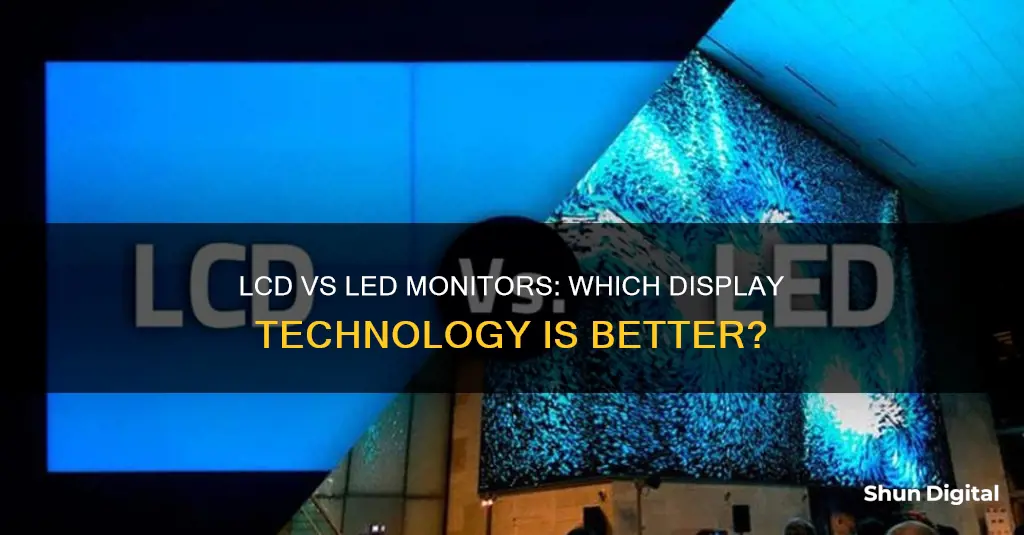
If you're in the market for a new monitor, you'll likely come across the terms LCD and LED. But what exactly is the difference between the two? LCD stands for Liquid Crystal Display, which uses liquid crystals to control light passage and create images on a screen. LED, or Light Emitting Diode, is a specific type of LCD that uses LEDs for backlighting instead of traditional fluorescent lights. So, when deciding between an LCD and an LED monitor, what are the key factors to consider?
| Characteristics | Values |
|---|---|
| Display type | LCD (Liquid Crystal Display) |
| Backlight type | LED (Light-Emitting Diode) |
| Image quality | LED offers superior picture quality with better contrast ratios and deeper black tones compared to LCD |
| Energy efficiency | LED is more energy-efficient and consumes less power, resulting in lower electricity bills |
| Slim design | LED allows for thinner and more compact designs |
| Cost | LED used to be more expensive, but prices have become more competitive as the technology has advanced and become more widespread |
| Common use cases | LCD is prevalent in the budget segment of the computer monitor market, while LED is the standard in the television market |
| Emerging trends | Mini-LED and micro-LED screens offer enhanced picture quality and are gaining traction in high-end gaming and professional content creation markets |
What You'll Learn

LED monitors are more energy-efficient
When it comes to energy efficiency, LED monitors have a clear advantage over traditional LCD monitors. This is mainly due to the backlighting technology used in LED monitors, which requires less power to produce the same level of brightness as LCD screens.
LED monitors use Light Emitting Diodes (LEDs) for backlighting, while LCD monitors typically use cold cathode fluorescent lamps (CCFLs). LEDs are more energy-efficient than CCFLs, resulting in lower power consumption for LED monitors. On average, LED monitors consume about 20-30% less power than LCD monitors. This can lead to reduced electricity bills over time, making LED monitors a more cost-effective option in the long run.
The superior energy efficiency of LED monitors is also evident in their longer lifespan. LED backlights typically last 50,000 to 100,000 hours, compared to 30,000 to 60,000 hours for CCFL backlights in LCD monitors. This extended lifespan not only reduces the need for frequent replacements but also contributes to lower overall energy consumption over the monitor's lifetime.
Additionally, LED monitors often have better power management features. They offer more precise control over screen brightness, allowing users to adjust the brightness to suit their needs and the ambient lighting conditions. This flexibility in brightness control further contributes to the energy efficiency of LED monitors.
It's worth noting that the energy efficiency of monitors can vary depending on their specifications, such as resolution, screen size, and brightness. However, when comparing LED and LCD monitors with similar specifications, LED technology generally emerges as the more energy-efficient option.
In summary, if energy efficiency is a priority for you when choosing a monitor, an LED monitor is likely to be the better choice. Its lower power consumption, longer lifespan, and improved power management features make it a more environmentally friendly and cost-effective option compared to traditional LCD monitors.
Monitoring Internet Usage on iPads: A Comprehensive Guide
You may want to see also

LCD monitors are cheaper
When it comes to choosing between an LCD or LED monitor, it's important to understand the differences between the two technologies and how they can impact your specific needs. While LED monitors offer several advantages, there are valid reasons why LCD monitors are still a popular choice, especially when it comes to cost.
LCD monitors are generally more affordable than LED monitors, making them a budget-friendly option for those who don't want to break the bank. This cost consideration is crucial for users with basic computing needs or those who are conscious of their spending. The affordability of LCD monitors allows users to strike a balance between performance and budget constraints.
Although LED technology has largely replaced traditional LCDs in the television market, LCD monitors remain prevalent in the budget segment of the computer monitor market. This is because LCD monitors provide a viable option for users who seek a functional display without compromising their financial limitations.
While LCD monitors may not offer the same level of picture quality as LED monitors, they still deliver decent colour accuracy and energy efficiency. LCD monitors are also known for their thin and lightweight design, making them ideal for slim laptops and portable displays. This design advantage ensures that LCD monitors remain a competitive choice for those seeking sleek and compact displays without a hefty price tag.
In addition, LCD monitors have certain unique benefits that cater to specific user preferences. For instance, many LCD monitors come with matte screens, which effectively reduce glare in bright environments. This feature can be particularly useful for individuals who work in well-lit spaces or outdoors.
Furthermore, traditional LCDs often provide more uniform backlighting across the entire screen, resulting in consistent lighting that some users may prefer. The consistent lighting of LCD monitors ensures that all areas of the screen maintain similar brightness levels, creating a balanced visual experience.
In summary, while LED monitors offer enhanced performance in various aspects, LCD monitors remain a popular choice due to their cost-effectiveness, decent image quality, energy efficiency, and design advantages. For users who prioritise affordability, basic functionality, and specific features like matte screens and uniform backlighting, LCD monitors are a sensible and practical option.
Connecting Cable to Monitor: A Step-by-Step Guide
You may want to see also

LED monitors have better picture quality
LED monitors offer superior picture quality to LCD monitors. LED monitors, especially those with full-array backlighting, generally offer superior picture quality with better contrast ratios and deeper blacks compared to an LCD display.
LCD monitors can still provide good image quality but often struggle to produce true blacks. LED monitors, on the other hand, are backlit by light-emitting diodes, which offer a superior LED display with better colour accuracy and improved visual clarity. LED monitors also have a longer lifespan than LCD monitors, with LED backlights lasting 50,000 to 100,000 hours compared to the 30,000 to 60,000 hours of CCFL backlights in LCD monitors.
The use of LED backlighting technology in LED monitors allows for more precise control over screen brightness and better power management features, resulting in lower power consumption and reduced electricity bills over time. LED monitors also tend to offer wider viewing angles than LCD monitors, with colours and contrast remaining more consistent when viewing the screen from different angles.
In addition to superior picture quality, LED monitors also offer faster response times, making them a better choice for gaming and graphic design. LED monitors with full-array backlighting and IPS panels are particularly well-suited for these tasks due to their high colour accuracy, dimming capability and ample viewing angles.
Pixel Size: Monitor Viewing and Resolution Clarity
You may want to see also

LED monitors are thinner and more lightweight
The slim design of LED monitors is due in part to the use of edge-lit or direct-lit LED backlighting. Edge-lit LEDs are positioned around the edges of the screen, resulting in a slim profile, while direct-lit LEDs are placed behind the entire screen, providing more uniform brightness. This makes LED monitors thinner and more lightweight than LCD monitors, which traditionally use cold cathode fluorescent lamps (CCFLs) for backlighting.
The compact design of LED monitors is also a result of the energy efficiency of LEDs. LEDs consume less power than CCFLs, which means that LED monitors can use smaller power supplies and other components, contributing to their thinner and more lightweight design.
In addition to their slim design, LED monitors offer superior picture quality and improved colour accuracy compared to LCD monitors. This is because LEDs allow for more precise control of the backlighting, resulting in higher contrast ratios and deeper black tones.
While LED monitors were initially more expensive than LCD monitors, the price difference has diminished as the technology has become more widespread. Today, LED monitors are often competitively priced, making them an attractive option for budget-conscious consumers who want a thin and lightweight display without compromising on picture quality.
When is the Release Date of that HP Monitor?
You may want to see also

LED monitors have a longer lifespan
When it comes to lifespan, LED monitors have a clear advantage over their LCD counterparts. LED backlights typically last 50,000 to 100,000 hours, while CCFL backlights in traditional LCDs last only about 30,000 to 60,000 hours. This means that LED monitors can offer up to twice the lifespan of LCD monitors, providing a more durable and cost-effective option in the long run.
The longer lifespan of LED monitors is due in part to their more advanced backlighting technology. LED monitors use Light Emitting Diodes (LEDs) for backlighting, while LCD monitors typically use cold cathode fluorescent lamps (CCFLs). LEDs are more energy-efficient, requiring less power to produce the same level of brightness as CCFLs. This lower power consumption not only reduces electricity costs but also contributes to the extended lifespan of LED monitors.
Additionally, LED monitors provide superior brightness control, allowing users to adjust the brightness to comfortable levels. This is important because higher brightness settings can lead to faster burnout of bulbs, reducing the overall lifespan of the monitor. LED monitors also have reduced flicker and often include blue light filtering options, which can further help reduce eye strain and prolong the lifespan of the display.
The construction and quality of the monitor also play a significant role in its longevity. A well-designed LED monitor with good cooling and heat dissipation mechanisms will last longer. The power supply and the quality of electrical components are other critical factors influencing the lifespan of the display.
It is worth noting that the environment in which the monitor is used can impact its lifespan. For example, operating in high-temperature environments can accelerate diode degradation, while extreme cold can extend the life of the display. Additionally, the content displayed can affect the lifespan; using darker colours or greys will result in lower power output and less strain on the diodes.
Monitoring Contractions: Tracking Time and Distance for Expectant Mothers
You may want to see also
Frequently asked questions
LCD stands for Liquid Crystal Display, which uses liquid crystals to control light passage. LED monitors, on the other hand, use Light Emitting Diodes for backlighting. All LED monitors are a type of LCD monitor, but not all LCDs use LED backlighting.
LCD monitors are generally more affordable, making them a good choice for those on a budget. They also tend to have more uniform backlighting and emit less blue light, which can help reduce eye strain.
LED monitors offer superior picture quality with better colour accuracy, higher contrast ratios and improved overall image sharpness. They are also more energy-efficient, slimmer, and have a longer lifespan than LCD monitors.
For gaming, an LED monitor with full-array backlighting is usually recommended due to its higher contrast ratios, better colour accuracy, and faster response times. However, if you are on a budget, a high-quality LCD monitor with a high refresh rate can still provide a good gaming experience.







